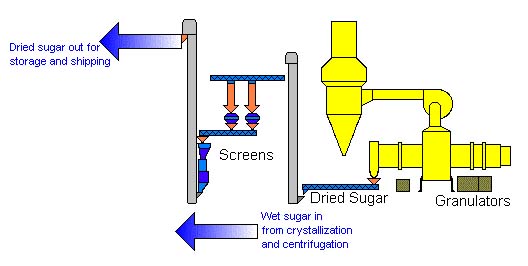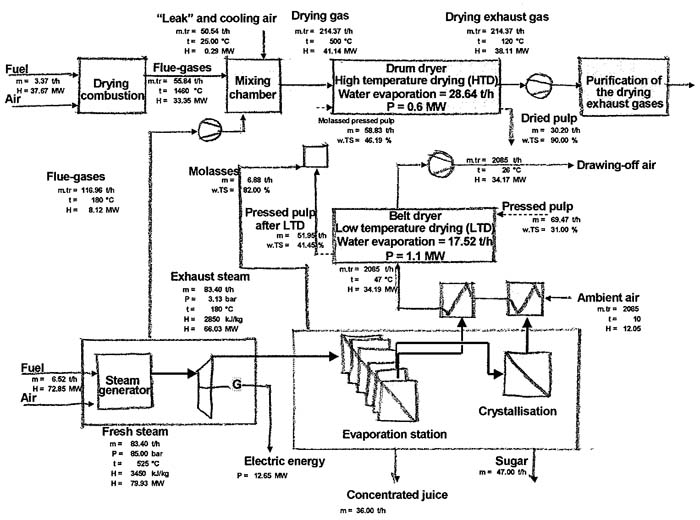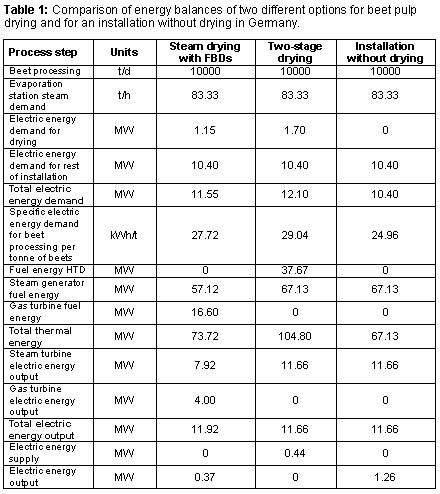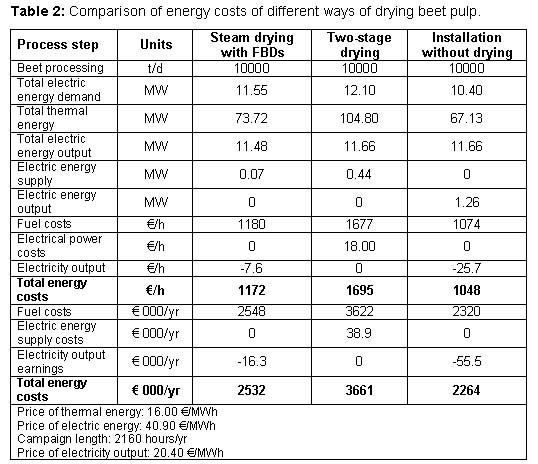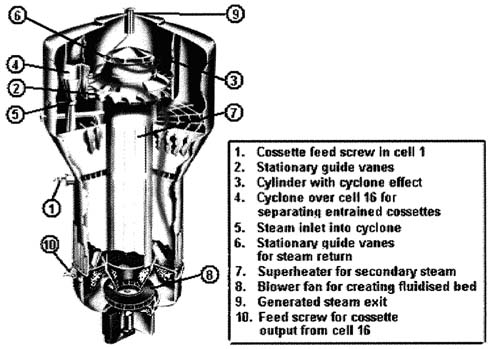Drying in sugar production
BACK to
1. DESCRIPTION OF TECHNIQUES, METHODS AND EQUIPMENT
- Method description
The remaining moisture of crystallised sugar from the A-product centrifugals has to be removed, to improve the keeping quality of the sugar. This is done using either:
a) Rotary Louvre Dryers: These are rotating drums which pick sugar up in louvres before dropping it through a stream of air.
b) Fluidised Bed Dryers: Heated air passes through nozzles into the sugar and fluidises it.
Figure 1: Sugar drying process LITERATURE: http://www.monitorsugar.com/htmtext/btintro.htm
2. NEW TECHNOLOGIES
- a) Changes in the process
After extracting sugar from cossettes, the beet pulp is pressed. The beet pulp is dried, then pressed and sold as animal feed. The decision on whether to dry sugar beet pulp depends on factors such as whether there is a nearby outlet for the wet pulp, e.g. for animal feed. In several european countries, e.g. France, beet pulp may be dried in installations which usually belong to farmers and are not directly connected to the sugar production process.
- Two-stage drying of sugar beet pulp: (BAT in the Food, Drink and Milk Industries, June 2005)
- a) Description of the technology:
- a) Description of the technology:
- For molasses-treated pulp drying, the first step is a low temperature drying (LTD) of the pulp using a belt dryer. Molasses are mixed to the pulp, and then the whole mixture is dried with a high temperature dryer (HTD) in a rotary drum dryer. LTD is used as a first step to make use of the lower energy heat from the HTD step and from the sugar production processes.
- This method results in reduced energy consumption comparing to one step HTD. Drying the pulp produces animal feed that can be stored for a longer time than moist feed.
- The flowsheet of two-stage pulp drying process is presented below. The data are standardized for a factory with a capacity of 10000t/d (417t/h) of sugar beet pulp. Here, about 62% of the total water is evaporated in the HTD stage.
- For molasses-treated pulp drying, the first step is a low temperature drying (LTD) of the pulp using a belt dryer. Molasses are mixed to the pulp, and then the whole mixture is dried with a high temperature dryer (HTD) in a rotary drum dryer. LTD is used as a first step to make use of the lower energy heat from the HTD step and from the sugar production processes.
Figure 2: Two-stage drying of sugar beet pulp. LITERATURE: BAT for Food, Drink and Milk Industries, June 2005
- The following table shows the energy demand and production data for two-stage drying and steam drying with FBDs. For comparison purposes, data for an installation without drying the pressed pulp are also included:
- The following table shows the energy demand and production data for two-stage drying and steam drying with FBDs. For comparison purposes, data for an installation without drying the pressed pulp are also included:
LITERATURE: BAT for Food, Drink and Milk Industries, June 2005
- b) Description of suitable energy supply systems:
- b) Description of suitable energy supply systems:
- Most belt driers operate with hot air at approximately 60°C, which can be heated using the heat streams from the evaporation station and crystallization unit of the sugar installation, which would otherwise be lost in the environment as waste heat.
- This use of secondary energy from the sugar production process shows an advantage to beet pulp drying of carrying out sugar production and beet pulp drying at the same installation. This may be done if the heat is not re-used within the sugar production process.
- The waste water produced by the condensation of the vapours created at the HTD step are either sent to a WWTP or for landspreading.
- Most belt driers operate with hot air at approximately 60°C, which can be heated using the heat streams from the evaporation station and crystallization unit of the sugar installation, which would otherwise be lost in the environment as waste heat.
- c) Possible energy savings reachable by those measures:
- c) Possible energy savings reachable by those measures:
- If two-stage drying is applied, about 30% energy can be saved using the vapours of the HTD step for the first step (LTD).
- If two-stage drying is applied, about 30% energy can be saved using the vapours of the HTD step for the first step (LTD).
- d) Economic evaluations:
- d) Economic evaluations:
- In the table below, the selected data for a feasibility comparison of the example plants are summarized. The quoted figures are only valid for the conditions given above. Possible minor differences in revenue for by-products are disregarded.
- In the table below, the selected data for a feasibility comparison of the example plants are summarized. The quoted figures are only valid for the conditions given above. Possible minor differences in revenue for by-products are disregarded.
LITERATURE: BAT for Food, Drink and Milk Industries, June 2005
- Steam drying with FBDs and two-stage drying have practically the same NVP, while HTD is cheaper by about 6%. However, if the calculations are done with a longer operational life, i.e. 18 years, for the driers and the gas turbine, the NVP of steam drying with FBDs is the lowest, e.g. lower cost.
- Steam drying with FBDs and two-stage drying have practically the same NVP, while HTD is cheaper by about 6%. However, if the calculations are done with a longer operational life, i.e. 18 years, for the driers and the gas turbine, the NVP of steam drying with FBDs is the lowest, e.g. lower cost.
- Steam drying of sugar beet pulp: (BAT in the Food, Drink and Milk Industries, June 2005)
- a) Description of the technology:
- a) Description of the technology:
- Drying is achieved by using superheated steam. If the steam is at 130°C, it expands and the temperature drops to 102-103°C at around 0.1MPa by the uptake of water. If the steam is at 260°C at around 2.6MPa, it expands and the temperature drops to 148°C at around 0.37MPa. FBDs can be used in steam drying.
- This method results in reduced emissions of dust and odour, compared to HTD. As a flue-gas is not used, NOX is not released. Another advantage is the lower overall energy consumption for drying compared to two-stage drying. The energy output, e.g. steam, can be re-used in the sugar extraction process. Drying the pulp produced animal feed that can be stored for a longer time than moist feed.
- The closed design of steam drying has the advantage of reducing the escape of gaseous emissions, e.g. dust and odour, however the venting of gases is required to maintain heat transfer in the FBDs. It is reported that the concentration of malodorous compounds in the exhaust air of FBDs is 5-10 times higher than in HTD.
- In the case of steam driers, the water content of the exhaust gases is normally removed by condensation. A significant amount of condensate is produced in this process. Figures for steam drying using FBDs show that about 0.6-0.7 tonne condensate per tonne of pressed pulp are generated with an organic load of 0.20-0.25kg TOC per tonne of pressed pulp.
- It is reported that due to the quantities of steam required for the steam drying of sugar beet pulp it is only viable to use this technique at installations which also refine sugar.
- In the figure below, the schematic diagram of steam drying with FBDs used for drying sugar beet cossettes is presented:
- Drying is achieved by using superheated steam. If the steam is at 130°C, it expands and the temperature drops to 102-103°C at around 0.1MPa by the uptake of water. If the steam is at 260°C at around 2.6MPa, it expands and the temperature drops to 148°C at around 0.37MPa. FBDs can be used in steam drying.
Figure 3: Schematic diagram of steam drying with FBDs used for drying sugar beet cossettes. LITERATURE: BAT for Food, Drink and Milk Industries, June 2005
- b) Description of suitable energy supply systems:
- b) Description of suitable energy supply systems:
- Steam drying with FBDs with an integrated steam system can be used in new sugar installations. For existing installations it may require complete reconstruction of the energy generation and heat switching facilities. Retrofitting involves reconstructing the steam generation and electricity production sections including, e.g. revising the entire heat transfer arrangements within the installation.
- Steam drying with FBDs with an integrated steam system can be used in new sugar installations. For existing installations it may require complete reconstruction of the energy generation and heat switching facilities. Retrofitting involves reconstructing the steam generation and electricity production sections including, e.g. revising the entire heat transfer arrangements within the installation.
- c) Possible energy savings reachable by those measures:
- c) Possible energy savings reachable by those measures:
- If two-stage drying is applied, about 30% energy can be saved using the vapours of the HTD step for the first step (LTD).
- If two-stage drying is applied, about 30% energy can be saved using the vapours of the HTD step for the first step (LTD).
- d) Economic evaluations:
- d) Economic evaluations:
- Steam drying with FBDs and two-stage drying have practically the same NVP, while HTD is cheaper by about 6%. However, if the calculations are done with a longer operational life, i.e. 18 years, for the driers and the gas turbine, the NVP of steam drying with FBDs is the lowest, e.g. lower cost.
- Steam drying with FBDs and two-stage drying have practically the same NVP, while HTD is cheaper by about 6%. However, if the calculations are done with a longer operational life, i.e. 18 years, for the driers and the gas turbine, the NVP of steam drying with FBDs is the lowest, e.g. lower cost.
- b) Changes in the energy distribution system
No information is available.
- c) Changes in the heat supply system
No information is available.
3. Case studies
BACK to
